Throughout history, many cultures have placed great value on the natural world. Unfortunately, our modern world is often blind to this value. In fact, the modern world is one insulated from nature. We destroy natural habitats to clear land for roads, buildings, and farmland. And a significant portion of our urban spaces lack greenery. However, we can reintegrate nature into our lives by creating urban green spaces. These offer various benefits, both to us, and to the environment.
“The western world is now suffering from the limited moral outlook of the three previous generations… The two evils are one, the ignoration of the true relation of each organism to its environment; and the other, the habit of ignoring the intrinsic worth of the environment which must be allowed its weight in any consideration of final ends”.
Alfred North Whitehead (1925) in “Science and the Modern World”
What are urban green spaces?
So, what are urban green spaces (UGS)? Put simply, any space in an urban area with growing plant life. The World Health Organisation (WHO) provides examples:
Smaller Green Spaces
- Street trees
- Roadside vegetation
- Greenery along rail tracks
Private Green Spaces (No public access)
- Green roofs and facades
- Gardens or green spaces on private grounds
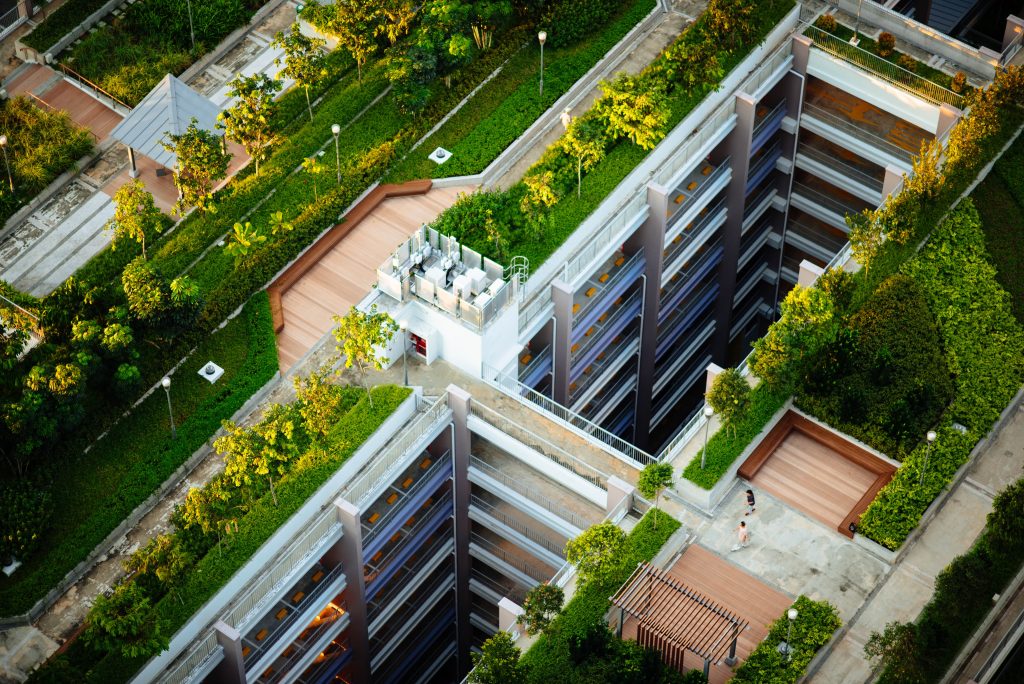
Larger Green Spaces for recreational functions
- Parks
- Playgrounds
- Community gardens
- Sport and play areas
- School grounds
- Green corridors
- Urban woodlands
- Natural wildlife areas
Why is it important to have green spaces in cities?
There are several reasons why urban green spaces are so important. Firstly, access to green spaces improves health and wellbeing. This is particularly important for children. In fact, in 2016 the WHO Regional Office for Europe reviewed access to urban green spaces. Their report stressed the importance of green spaces for play and physical activity. As such, the United Nations (UN) include urban green spaces as a sustainability metric. Specifically, the UN Sustainable Development Goal (SDG) 11: Sustainable Cities and Communities. Secondly, green spaces improve the environment. They improve air and water quality, reduce noise levels, and act as heat and carbon sinks.
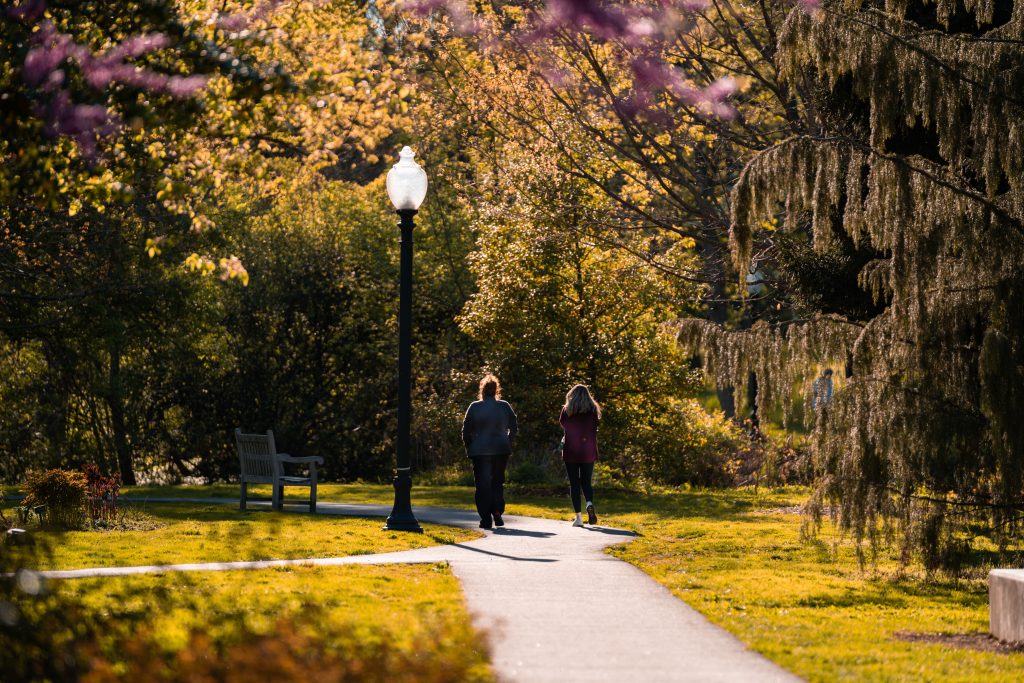
Environmental benefits of Urban Green Spaces.
Globally, air pollution causes 7 million premature deaths each year. Outdoor air pollution is causing almost half of those deaths due to chronic diseases. Cities also suffer from the urban heat island effect. This causes heat stress during heat waves, which can lead to fatal heat stroke. As climate change accelerates, these effects become more frequent, including related heat waves.
Urban areas without green spaces also discourage walking. In part, this is due to a lack of access to recreational areas. Physical exertion is also harder during heat waves. These conditions contribute to physical inactivity among urban populations, which increases health risks. So, urban green spaces reduce air pollution, lower the temperature, and encourage exercise.
Health and Well-being benefits of Urban Green Spaces.
Urban green spaces improve health and well-being. The WHO and other institutional sources have collected the evidence in academic literature. Figure 1 (below) displays their model for the impacts of UGS’s on health and well-being. This data suggests that UGS’s reduce environmental health risks associated with urban living. This includes improving air and water quality and reducing noise levels. Plus, being in nature delivers other health and well-being benefits. It reduces stress and improves relaxation and overall mental health. The physical activity has obvious benefits for your physical fitness levels. It can also increase social interaction and a sense of community. Thus, urban green spaces generally lower death rates.
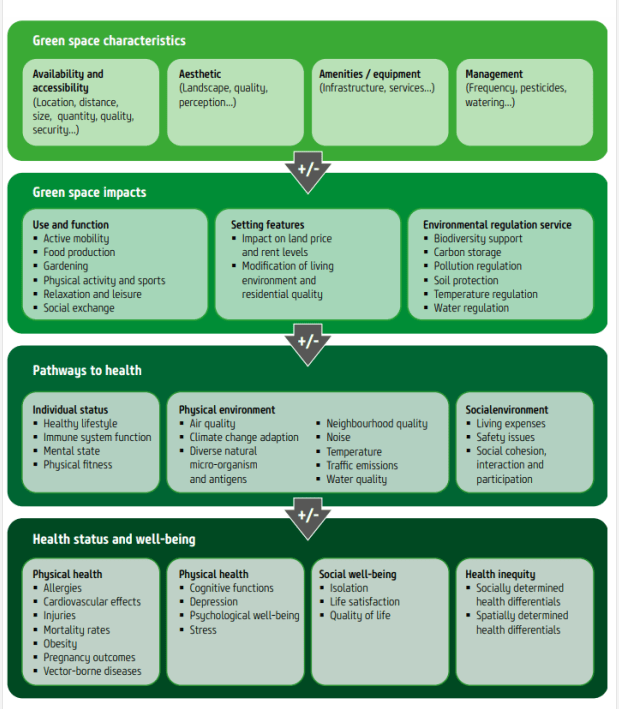
How does nature improve mental health?
Spending time in nature helps people cope with stress. Major stressful life events can cause significant physical and mental health problems. The spread of COVID-19 in 2020 was an event that impacted a large fraction of the global population. Lockdowns and restrictions reduced the spread of the virus, but also increased stress. This period is thus marked by global health risks and behavioural changes. However, it also provided a unique opportunity to see how green spaces help people. Scientists examined changes in the UGS use. They were also able to investigate people’s reasons for using green spaces. And they could measure the role of green spaces as a coping mechanism for stressful life events.
Case study: Urban Green Spaces in Brisbane, Australia.
Scientists performed a case study in Brisbane, Australia, during the COVID-19 pandemic. The pandemic acted as a stressful life event shared by most of the global community. Thus, scientists could measure the role of green spaces as a coping mechanism for stress. They found that UGS’s can reduce many of the stresses associated with urban living. Stressful life events increase stress, depression, and a decrease in mental well-being. However, “nature experiences” can reduce the negative impacts of stressful life events.
The stress of the pandemic changed the way people interacted with green spaces. Nature group walks decreased perceived stress and depression, and increased mental well-being. Experiencing nature also assisted rehabilitation for people severely affected by a life crisis. The same study also looked at the effects of proximity to green spaces. Patients with green spaces within 3 km of their home had better mental and general health. Further, easy access to UGS increased their restorative benefits during restrictions.
Other studies show that even small UGS, like pocket parks, provide health benefits. This is mainly through psychological restoration, or recreation. These findings are particularly important when determining the value of green spaces. People will visit any green space for the benefits, particularly psychological restoration.
However, accessible UGS’s in densely populated neighbourhoods can overcrowd easily. This may cause discomfort and health risks for some people.
Green space management
The colossal rise in urbanisation is synonymous with continuous degradation of the environment. Our continued growth also increases energy use and reduces biodiversity. The impacts on biodiversity, and human health threaten the survival of urbanisation itself.
Conventional economics believes stock market prices reflect the true value of resources. As such, these prices determine allocation and distribution of resources. However, time has revealed serious flaws in this understanding of economics. Conventional economics conceals complexities and makes oversimplistic assumptions about the real world. That is, it assumes it is ‘Hermetic’, meaning a sealed or closed system. This view is only helpful in giving an approximate picture of reality. Furthermore, applying mainstream economic tools to the environment led to faulty decisions. Thus, the basic methodology behind mainstream economic tools may have serious shortcomings.
The most significant oversight is not considering environmental impacts. For example, they assign no value to common property resources like grazing grounds. This is because these resources aren’t traded. The quality of these resources is thus overlooked. Plus, an efficient use of resources would arguably not cause such environmental degradation. After all, these resources are an indispensable component for human survival.
These resources include ecosystem services such as:
- control of climate change,
- protection from harmful UV rays,
- oxygen production
- recreational experiences
Sustainable development and Urban Green Spaces
In recent years, a new discipline called ‘ecological economics’, has emerged. This has resulted in the establishment of several international platforms. These include the Economics of Ecosystem Services and Biodiversity (TEEB) and the Intergovernmental Platform on Biodiversity and Ecosystem Services. Ecological economics aims to resolve cross-cutting issues in economics and ecology. As such, it is a transdisciplinary area that combines approaches from both disciplines.
Ecological economics focuses on urban ecosystems. At the community level, urban ecosystems contain people who live in high densities. This also includes places where the built infrastructure covers large areas of land. Notably, the infrastructures in these areas can contain vegetation and water bodies. This can include urban forests, parks and gardens, ponds, small lakes and wetlands. However, in a broader sense, these are still urban areas.
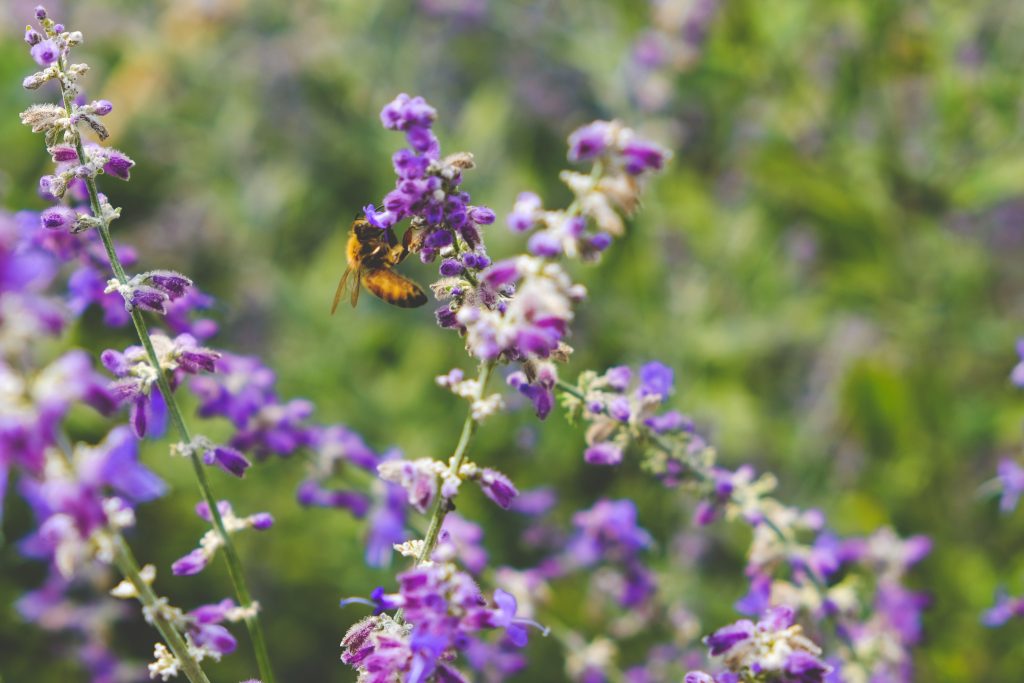
Preserving natural habitats and biodiversity is a key part of ecological management. To that end, sustainable development requires careful urban planning. Having sufficient green spaces in urban areas is part of that. Those spaces must also be appropriate to the existing environment. Lawns and manicured gardens which transplant native fauna still damage local biodiversity. To thrive, we must find a way to integrate urban design with nature.
Economics and Sustainable Development
Increasing worldwide awareness of climate change has driven new trends in development. Indeed, ‘sustainable development‘ is now a prominent phrase. It means meeting our current needs, without preventing future generations from meeting theirs. Currently, ecological economists believe in strong sustainability. This preserves natural capital since it is a steady source of inputs for production. Currently, the rate at which we exploit resources is unsustainable. We will run out. This has been made clear in the wake of the rapid growth of urban built-up structures. As a result, all governmental levels are reconsidering their stock of natural capital.
Separately, economics and ecology fail to form a complete understanding of environmental issues. As an amalgamation of these two disciplines, ecological economics aims to do better. The principles of economics or markets are omnipresent. They impact every choice we make, which in turn affects the environment. The valuation of ecosystem services is at the very core of ecological economics. Unfortunately, commitment to sustainable development has not yet involved mainstreaming ecological economics. Conventional economics still dominate the functioning of the world.
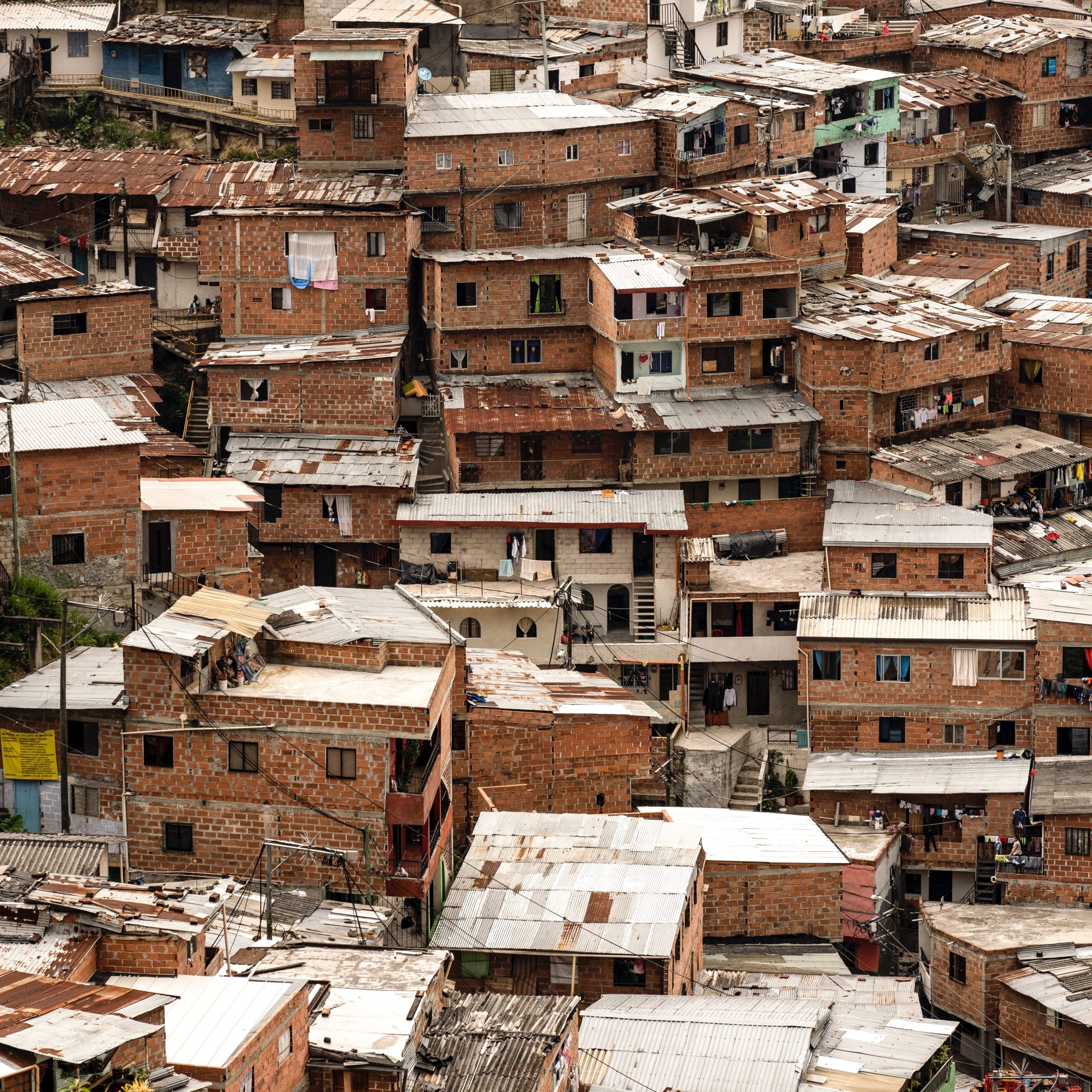
Urban planning in the Global North vs South
In some ways, urban green spaces are a privilege of the Global North. That is, planning, designing and implementing UGS’s is common for Global North countries. Indeed, deliberate planning for urban development is itself a privilege. In contrast, most Global South countries contain large informal settlements in urban areas. These slums are the legacy of colonialism and post-colonialism. Although, extremely high rates of urban population growth also contribute. As a result, urban planning and design is difficult. Planned green spaces are thus rare, and mainly concentrated in natural wildlife areas. This context is relevant when discussing differences of green spaces between the Global North and Global South. Green space areas in the Global South should be seen as a long-term investment with a decades-long perspective.
How can we add more greenery?
Integrating urban life with the natural world has clear benefits. Urban green spaces offer multi-faceted improvements to human health and well-being. However, UGS are uncommon because we value capital growth over health and well-being. To increase sustainable development, we must re-evaluate our economic systems.
One way to help increase urban green spaces is to petition your local council. If your local council isn’t listening, try reaching out to the media. You can also increase your own access to greenery with pot plants. And if you’re feeling run-down, get outside and go for a nature walk. It can really help!
THRIVE is a not-for-profit, for-impact organisation. We aim to promote sustainability and advocate for progress on global initiatives. If you found this article helpful, consider donating to support the cause.
This article was written in collaboration with Rolf Pfotenhauer, Shadi Kafimallak, and Rebecca Deer.























